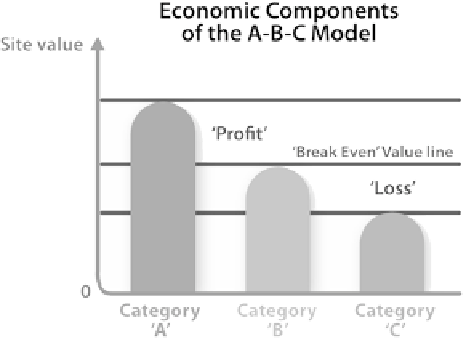Environmental Engineering Reference
In-Depth Information
25.9 Typologies of Brownfield Sites
A typology is a way of describing a characteristic of a phenomenon: in this
case Brownfield sites. The consequences of different definitions is illustrated in
Table
25.2
.
25.9.1 Economic
CLARINET (Ferber and Grimski
2002
) proposed a three fold classification
of Brownfield sites depending on the profitability of regeneration (Fig.
25.4
).
CABERNET (
2006
) developed the concept and analysed the role of private and
public sector finance (Fig.
25.5
). The ratio of reclamation costs and site value defines
three types of sites. Where a profit is still to be made (“Type A sites”) the private
sector will undertake the reclamation process in a conventional investment project.
In many situations, however, private developers and financiers are not able, or will-
ing, to act on their own to ensure that the full economic potential of site reuse will be
achieved (“Type B sites”). This means that Brownfield properties are often under-
used, because the perceived costs and risks of bringing them back into use exceeds
the benefits to their owners. Thus some kind of public sector intervention is nec-
essary to bring the land back into productive use (Alker et al. 2000). Where the
reclamation costs are broadly equal to the site value, or uplift in site value, then
public-private partnerships or the creation of infrastructure by the public sector can
attract private investment to a site. Sites where reclamation costs are much higher
than site value cannot reasonably be brought back in to economically beneficial use
(Type C sites). However, such sites can be reclaimed for the public good.
The need of quiet, the need of air, the need of exercise, and... the sight of sky and of things
growing seem human needs, common to all men. Octavia Hill (co-founder National Trust).
The Land Restoration Trust (LRT) (
2009
) recognises that “many physical
regeneration strategies prioritise regeneration for economic use. Whilst this is
important
it means that often land not suitable for commercial or industrial
Fig. 25.4
CABERNET
A-B-C model: The economic
components of Brownfield
sites (source: CABERNET
2006
, reproduced with
permission)

Search WWH ::

Custom Search